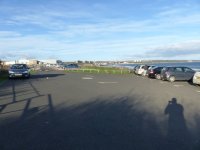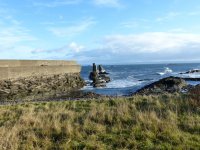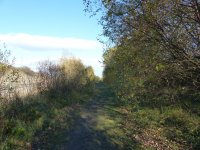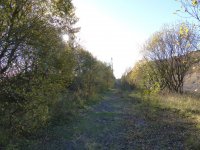Over the last few months, I have been covering a lot of ground, mainly in Fife, trying to get to know the best bird watching sites. Much as I enjoy doing this, and will continue to do so, I quickly came to the conclusion that I need to have a fairly local place to make my own "patch". A place I can make concentrated, regular observations at over a long period of time. I believe I have now identified that place.
My patch of choice will be the area around the Fife Coastal Path from the Seafield car park to Kinghorn. The path from the car park to Seafield Tower can be pretty busy, especially in Summer, with walkers/dog walkers. It is an area I have been watching on a fairly regular basis already. Beyond the tower towards Kinghorn, the path rises and falls a bit. The boundary to the West is the main railway line to Edinburgh. This section of the path is a little quieter (apart from the trains), and as I will reveal, there are a few secluded spots of interest that a birder can find his/her way into.
What has really attracted me to this area is the variety of habitats that promise a good variety of birds. Along the Seafield stretch you have good areas for waders and the rocks and broken down sea wall host many other types of seabird. The path does have some scrub here on the bank above which are the back gardens of some of the houses of the Seafield estate. Once you get beyond the estate and Seafield Tower itself, it is this area that you find a good mixture of various scrub, the most dominant being the Hawthorn that hems the path in at places. Where the path rises up to the railway line you get some good views down into scrub laden coves on the one side and some arable farmland (currently stubble fields) across the tracks. And of course there are excellent views across and down the Forth, with Bass Rock being a good landmark on clear days.
So, what I am going to initially do, is set the scene, so to speak. A picture paints a thousand words, so I am going to try and show, over the course of a few posts, the area I will be reporting on. In course of time, I will add my reports and also anything else of interest concerning this area. There will also be a species list that I will update as we go.
I hope this will be an enjoyable and informative thread for all to read, and if anyone can add any reports or pictures to it, I will be delighted.
To start with, I have attached some pictures of the approach to Seafield Tower and the climb to the South of it, with view back to the tower from the high point.
My patch of choice will be the area around the Fife Coastal Path from the Seafield car park to Kinghorn. The path from the car park to Seafield Tower can be pretty busy, especially in Summer, with walkers/dog walkers. It is an area I have been watching on a fairly regular basis already. Beyond the tower towards Kinghorn, the path rises and falls a bit. The boundary to the West is the main railway line to Edinburgh. This section of the path is a little quieter (apart from the trains), and as I will reveal, there are a few secluded spots of interest that a birder can find his/her way into.
What has really attracted me to this area is the variety of habitats that promise a good variety of birds. Along the Seafield stretch you have good areas for waders and the rocks and broken down sea wall host many other types of seabird. The path does have some scrub here on the bank above which are the back gardens of some of the houses of the Seafield estate. Once you get beyond the estate and Seafield Tower itself, it is this area that you find a good mixture of various scrub, the most dominant being the Hawthorn that hems the path in at places. Where the path rises up to the railway line you get some good views down into scrub laden coves on the one side and some arable farmland (currently stubble fields) across the tracks. And of course there are excellent views across and down the Forth, with Bass Rock being a good landmark on clear days.
So, what I am going to initially do, is set the scene, so to speak. A picture paints a thousand words, so I am going to try and show, over the course of a few posts, the area I will be reporting on. In course of time, I will add my reports and also anything else of interest concerning this area. There will also be a species list that I will update as we go.
I hope this will be an enjoyable and informative thread for all to read, and if anyone can add any reports or pictures to it, I will be delighted.
To start with, I have attached some pictures of the approach to Seafield Tower and the climb to the South of it, with view back to the tower from the high point.









































